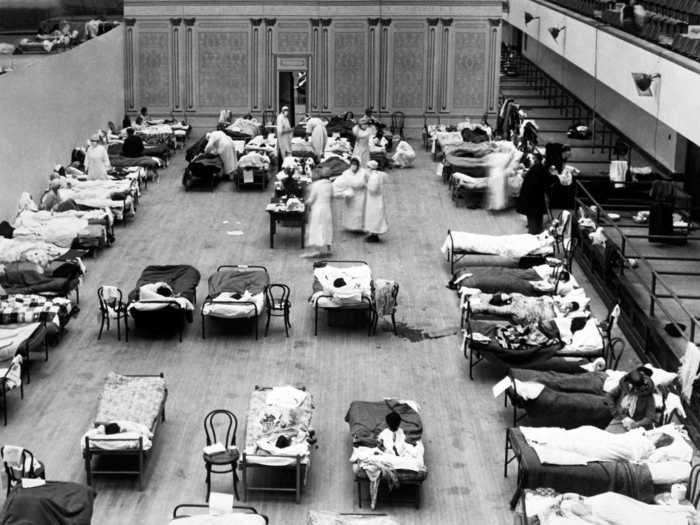
A policeman wearing a flu mask leads two men away from the Ferry Building in 1918.California State Library
San Francisco and the surrounding region has been lauded across the US for its stringent compliance with public health orders during the 2020 coronavirus pandemic.
It was one of the first to enter a shelter-in-place order on March 17. But it also happens to be the birthplace of the poster child of anti-mask sentiment during the 1918 Spanish flu pandemic.
The city enforced the wearing of masks during the 1918 pandemic. But some residents were dismissive, wearing them improperly out of apathy or to smoke, leading to hundreds of arrests. And some heartily fought back against the enforcement, believing that the masks were unsanitary, useless, and a threat to their constitutional rights.
An "Anti-Mask League" was formed in January 1919 in San Francisco, with its members — dubbed "Sanitary Spartacans" — fighting for the mask-wearing mandate to be repealed.
They eventually got their way, but only after San Francisco became one of the worst-hit cities in the US. Eventually, 45,000 residents were infected.
Anti-mask rhetoric is again present in the modern-day COVID-19 health crisis, as some protest mask-wearing and government shutdowns designed to stunt the spread of the disease.
Here's how San Francisco's so-called "mask slackers" and the Anti-Mask League clashed with city officials over laws mandating that residents cover their faces to help in the fight against the flu in 1918 and 1919.
Read the original article on Business Insider
It remains one of the worst pandemics in history.
The nations involved in World War I largely censored negative news except for Spain, which was neutral. And so the country's coverage of a threatening disease resulted in the belief that the flu originated there, and Spain became its namesake.

One of the many precautions that cities took in quelling the spread of the disease was mandating that residents wear masks.
And these weren't the N95s or other forms of masks that thousands are wearing during the 2020 coronavirus pandemic.

Some fashionable women at the time even simply wore pieces of chiffon as face coverings.

Public health messaging attempted to rebrand personal hygiene as a display of red-blooded patriotism, and masks eventually became a symbol of patriotic duty.
There was, however, some resistance to wearing masks, despite the belief shared by many that they were effective in containing the disease.


By mid-October 1918, there had been more than 20,000 cases of influenza and 1,000 deaths in the city so far.

Businesses, restaurants, and theaters were also closed, and the city's Board of Health advised people to avoid large crowds and gatherings.
But not everyone was devout in their adherence to the mask-wearing law.

Source: Stockton Daily Evening Record

Some served 30-day jail sentences, according to a report from the San Francisco Chronicle. Many more were gradually imprisoned in the following weeks for the same reason — the Chronicle reported 175 arrests on November 2, 1918.
The jails became overcrowded, with officers working double-duty to process cases.
Some incidents were more violent than others.

When a health inspector, Henry D. Miller, attempted to reprimand him, Wiser assaulted him and "knocked him to the ground." In his daze, Miller shot Wiser as well as two bystanders. No one was killed, but both men were arrested.

Restrictions started to lift on November 16. Theaters, entertainment venues, and sporting arenas began reopening, with patrons required by law to wear masks while inside for the time being.

However, they did so without masks, and police easily identified both men for their failure to comply. Hassler reasoned that his mask must have slipped as he took a drag from his cigar. He coughed up a $5 fine.
Mayor Rolph was fined $50 by the city's police chief a few days later.

As the Chronicle reported at the time, a whistle blew, and people joyfully flooded the streets and flung their masks to the wayside.


Officials placed all their bets on the use of masks and didn't bother shuttering businesses this time around.
A Red Cross ad placed in the San Francisco Chronicle urging members of the public to wear masks read: "A gauze mask is 99% proof against influenza. Doctors wear them. Those who do not wear them get sick. The man or woman or child who will not wear a mask now is a dangerous slacker."


But then 612 new cases were found on January 10, and the surge prompted Hassler to push for a reinstated mask law. On January 17, it was made official.

Others were skeptical of whether or not the masks were even effective in preventing the transmission of the disease, a view point that the state of California and other counties were also beginning to share.

Members included influential San Franciscans, a few physicians, and even a member of the Board of Supervisors.
A woman named Emma Harrington served as chairperson, according to records of a Board of Supervisors meeting. Harrington was an activist, the first woman to vote in the city of San Francisco in 1911, and was seeking the position of Justice of the Peace.
Another supporter of the league was Eugene Schmitz, a former mayor of San Francisco found guilty of taking bribes following the destructive 1906 earthquake. Nicknamed "Handsome Gene," he was sentenced to five years in prison shortly after the disaster.



The league crafted and submitted a petition to the city calling for the mask ordinance to be repealed. It read in part: "We earnestly pray that the people be granted speedy relief from the burdensome provisions of this measure."
The resolution was supported by a city supervisor, Charles Nelson, who declared the mask-wearing ordinance "an infringement of our personal liberty" and an affront to the "spirit of a truly democratic people."

Source: San Francisco Examiner

He said members of the league, which comprised about 4,000 people, were the only ones in the city making such drastic requests to rescind the ordinance.
"Do you think I am going to stultify myself here against the wish of 99 1/2 percent of the doctors; against the officials of the army and navy?" Rolph said during the meeting.

"I shall repeal this ordinance when the doctors, the Board of Health and common sense permit," he said according to a San Francisco Examiner article on January 28, 1919.
The mayor said that efforts should instead be focused on addressing more dire issues such as how to help soldiers reacclimate to everyday life when returning from war.
"We should give our minds to serious matters instead of fighting the little inconvenience occasioned by the wearing of a mask for the protection of the general public," Rolph said according to records of a Board of Supervisors meeting.

The number of new cases steadily decreased following January 16. An asterisk beside the January 17 record is accompanied by a note reading: "Mask law became effective."
On January 27, there were 54 new infections with 13 reported deaths.

On the same day, the Anti-Mask League held a meeting, where political turmoil spelled the end of the organization. Harrington was ousted as chairwoman, and the group fizzled out.

The population of the city at the time was about 500,000, according to census data.
For every 100,000, 673 died due to the flu or pneumonia that it caused, earning San Francisco one of the highest death rates in the country, the 13th highest out of 66 major US cities according to one study.

Source: Business Insider

Research from the California State Board of Health shows that 78% of nurses at San Francisco General Hospital were infected with the flu in 1918, despite diligent mask use.
However, a study conducted by the National Academy Sciences in 2007 found that the mortality rate was reduced by at least 25% thanks to the measures San Francisco put in place, which included mask-wearing mandates.

Implementing social distancing measures as early as possible — as well as sustaining them — is the most straightforward way to do that.
Wearing masks helps too, but they're not a silver bullet.

Covering our faces in public will likely be a mainstay for the foreseeable future.

Similar to how masks were a symbol of patriotism during the Spanish flu pandemic, masks have become politicized during the COVID-19 crisis.
A Costco worker recently turned a shopper away for not wearing a mask upon entry into a store, despite the company's mask policy for customers to do so as Business Insider's Mary Hanbury reports.
And a security guard working at a Family Dollar store in Flint, Michigan, was shot and killed after refusing to allow a customer to enter unless she instructed her daughter to put on a mask.
As Business Insider's Kate Taylor and Áine Cain report, retail workers are taking the bulk of the backlash from "anti-maskers" who are blowing off mask policies enforced by stores, states, and local governments.
"The employees are downright afraid to ask people to put on masks," Kroger employee and Michigan resident Kristine Holtham told reporters on Wednesday. "Believe me, if you ask someone to put on a mask, it's like asking them to throw their gun away."

Source: Business Insider

Source: Business Insider

Some protestors wear masks, some don't.

Oklahoma has also seen its fair share of dissent.

Source: CBS San Francisco

City leaders across the US are tasked with figuring out how to refuel economies and save businesses from going under while also containing the spread of COVID-19.

 I spent $2,000 for 7 nights in a 179-square-foot room on one of the world's largest cruise ships. Take a look inside my cabin.
I spent $2,000 for 7 nights in a 179-square-foot room on one of the world's largest cruise ships. Take a look inside my cabin. Saudi Arabia wants China to help fund its struggling $500 billion Neom megaproject. Investors may not be too excited.
Saudi Arabia wants China to help fund its struggling $500 billion Neom megaproject. Investors may not be too excited. Colon cancer rates are rising in young people. If you have two symptoms you should get a colonoscopy, a GI oncologist says.
Colon cancer rates are rising in young people. If you have two symptoms you should get a colonoscopy, a GI oncologist says. Catan adds climate change to the latest edition of the world-famous board game
Catan adds climate change to the latest edition of the world-famous board game
 Tired of blatant misinformation in the media? This video game can help you and your family fight fake news!
Tired of blatant misinformation in the media? This video game can help you and your family fight fake news!
 Tired of blatant misinformation in the media? This video game can help you and your family fight fake news!
Tired of blatant misinformation in the media? This video game can help you and your family fight fake news!

Copyright © 2024. Times Internet Limited. All rights reserved.For reprint rights. Times Syndication Service.